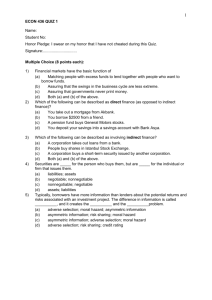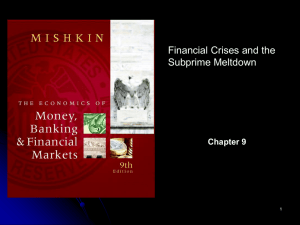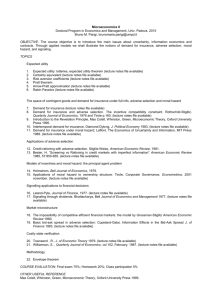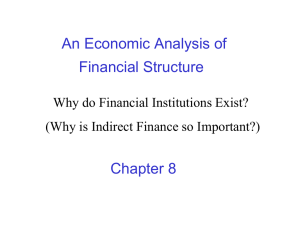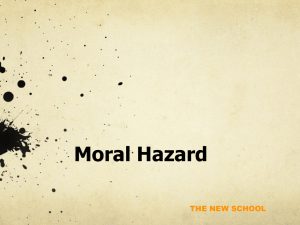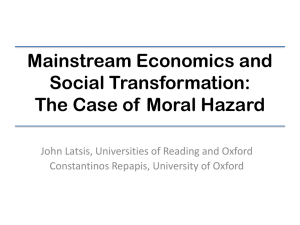Chapter 8 Test Bank - Holy Family University
advertisement
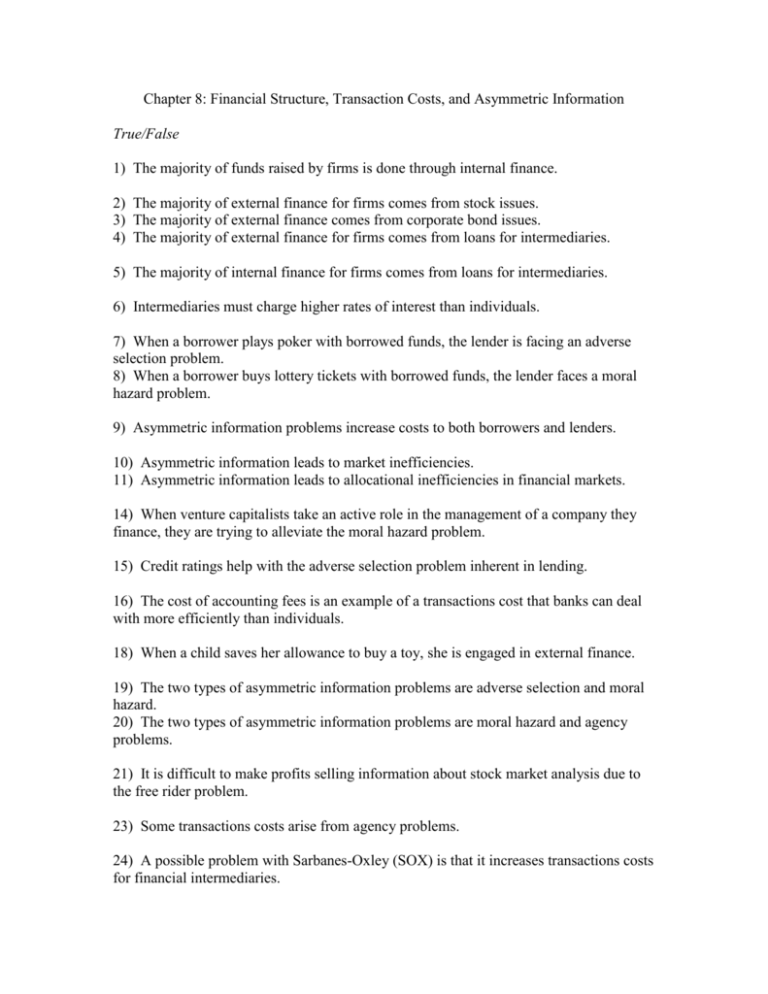
Chapter 8: Financial Structure, Transaction Costs, and Asymmetric Information True/False 1) The majority of funds raised by firms is done through internal finance. 2) The majority of external finance for firms comes from stock issues. 3) The majority of external finance comes from corporate bond issues. 4) The majority of external finance for firms comes from loans for intermediaries. 5) The majority of internal finance for firms comes from loans for intermediaries. 6) Intermediaries must charge higher rates of interest than individuals. 7) When a borrower plays poker with borrowed funds, the lender is facing an adverse selection problem. 8) When a borrower buys lottery tickets with borrowed funds, the lender faces a moral hazard problem. 9) Asymmetric information problems increase costs to both borrowers and lenders. 10) Asymmetric information leads to market inefficiencies. 11) Asymmetric information leads to allocational inefficiencies in financial markets. 14) When venture capitalists take an active role in the management of a company they finance, they are trying to alleviate the moral hazard problem. 15) Credit ratings help with the adverse selection problem inherent in lending. 16) The cost of accounting fees is an example of a transactions cost that banks can deal with more efficiently than individuals. 18) When a child saves her allowance to buy a toy, she is engaged in external finance. 19) The two types of asymmetric information problems are adverse selection and moral hazard. 20) The two types of asymmetric information problems are moral hazard and agency problems. 21) It is difficult to make profits selling information about stock market analysis due to the free rider problem. 23) Some transactions costs arise from agency problems. 24) A possible problem with Sarbanes-Oxley (SOX) is that it increases transactions costs for financial intermediaries. 25) A possible problem with Sarbanes-Oxley is that in worsens the free-rider problem for financial intermediaries. 26) Laws against fraudulent reporting on financial documents are an attempt to reduce agency problems. 28) Specialized lending is intended to minimize adverse selection problems. Multiple Choice 1) Which of the following does NOT involve a financial intermediary? a) saving for retirement b) buying a treasury bond from the government c) buying stock online d) They all involve an intermediary. 2) Which of the following does NOT involve a financial intermediary? a) saving for retirement b) taking a loan to start a business c) buying stock online d) They all involve an intermediary. 3) Which are examples of external finance? a) issuing commercial paper b) stock sales c) issuing bonds d) all of the above 4) Which of the following is an example of a source of internal finance? a) corporate bonds b) withheld earnings c) commercial loans d) none of the above 5) Which of the following is a technique lenders use to alleviate the adverse selection problem? a) checking credit ratings b) monitoring borrower activity c) restrictive covenants d) all of the above 7) Which of the following is a technique lenders use to alleviate asymmetric information problems? a) specialized lending b) diversified lending c) requiring collateral d) all of the above (d, medium, sections 3-4) 8) Which of the following is a technique lenders use to alleviate moral hazard problems? a) specialized lending b) diversified lending c) requiring collateral d) all of the above 9) Which of the following is a technique lenders use to alleviate the adverse selection problem? a) screening b) monitoring borrower activity c) legal restrictions on the use of funds d) all of the above 11) Which of the following is a technique lenders use to alleviate the moral hazard problem? a) checking credit ratings b) monitoring borrower activity c) both of the above d) none of the above 12) Which of the following are examples of transactions costs faced by lenders? a) accounting fees b) legal fees c) monitoring costs d) all of the above 13) Restrictive covenants are required by lenders to help solve the problem of a) adverse selection. b) moral hazard. c) transactions costs. d) all of the above. 14) Specialized lending helps lenders solve the problem of a) adverse selection. b) moral hazard. c) transactions costs. d) all of the above. 16) Banks are said to ration credit when they refuse to lend above a certain interest rate. The purpose of such a policy is to minimize _____ of lending. a) adverse selection problems b) moral hazard problems c) transactions costs d) all of the above 18) Sarbanes-Oxley was intended to reduce a) asymmetric information. b) allocational efficiency. c) transactions costs. d) all of the above. 19) Sarbanes-Oxley may have unintentionally increased a) asymmetric information. b) allocational efficiency. c) transactions costs. d) all of the above. 20) Legislation banning fraudulent financial documentation is intended to reduce a) agency costs. b) efficiency. c) volatility. d) all of the above. 21) Legislation banning fraudulent financial documentation is intended to reduce a) agency costs. b) moral hazard problems. c) asymmetric information. d) all of the above. 22) The free-rider problem affects decisions of participants in a) the stock market. b) IPOs. c) both of the above. d) neither of the above. 23) The free-rider problem affects decisions of participants in a) the stock market. b) internal finance c) both of the above. d) neither of the above. 28) The free-rider problem affects the a) stock market. b) corporate bond market. c) both of the above. d) neither of the above. 29) Deductibles on car insurance are solutions to the _____ problem for insurers. a) b) c) d) adverse selection moral hazard free-rider all of the above Short Answer 1) What is a transactions cost that could arise from screening? e.g. Banks must hire people with expertise in financial statements 2) What are restrictive covenants? Are they directed at adverse selection or moral hazard problems? Restrictive covenants are legal restrictions on what borrowers can do with the loan. These affect behavior after the loan is made, so are directed at moral hazard problems. 3) Does screening help minimize adverse selection of moral hazard problems? Explain briefly. Screening is the process of deciding who is credit-worthy. Since it takes place before a loan is made, it helps with the adverse selection problem. 4) Joey’s Bank decides to make loans only to agricultural firms. Explain the pros and cons of this decision in terms of diversification and specialization. Making only agricultural loans reduces the diversification of the bank and exposes them to a downturn in that industry. It may benefit the bank, as specializing in a single industry may allow them to increase their expertise and make better lending decisions. 5) Banks commonly monitor the activities and check the credit ratings of borrowers. Which solves the moral hazard problem and which solves the adverse selection problem? Explain briefly. 7) What is the free-rider problem in relation to the stock market? Stock market investors do not have incentive to do research about stocks since they can emulate other investors who have. 8) Why is there a principal-agent problem for stock market investors? Stockholders of a company want managers to increase company earnings and profits while manager want to increase their own income. 10) How does the free-rider problem affect the size of the firms with access to the IPO market? The free-rider problem makes it costly to figure out the value of a firm. Therefore, smaller firms have difficulty gaining access to the IPO market. 11) How does compensating company managers with stock help with agency problems? What is the potential problem with this solution? If managers are compensated with stock, they have incentive to increase the value of the stock by increasing company profits just as investors in the stock desire. However, managers may also be tempted to increase profits temporarily to realize gains in the stock market, at the cost of the long term health of the company. 12) Credit rationing means that banks refuse to lend above a certain interest rate. Why would they do this? What does this policy have to do with adverse selection or moral hazard? Borrowers who are willing to take loans at high interest rate tend to be higher risk. By refusing these loans, banks are minimizing the adverse selection problem. 13) What does IPO stand for? What is it? IPO stands for initial public offering, meaning a firm issues stock through an investment bank. 14) During the housing crisis of 2008, many homeowners went “under water,” meaning their home is worth less than the value of their mortgage. What solution to asymmetric information problems is affected? Why is this a problem for lenders? The value of the collateral is the value of the home, which has declined. Consequently, there is greater incentive to default since losing the collateral is less onerous than paying off the loan. The moral hazard problems are worse, and banks will face more foreclosures.
